Why you should choose True Refrigeration’s upright cabinets
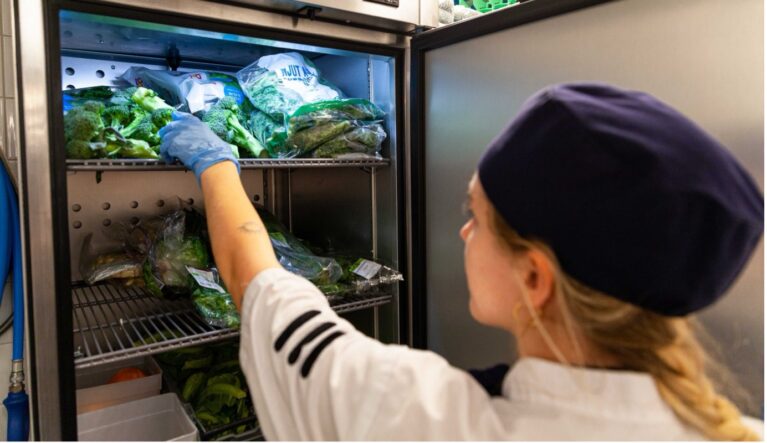

Because of its ruthless use in service, it must meet a variety of requirements in order to withstand the pressures of a busy food-service environment. It has to be powerful enough to keep its cool in hot conditions, whilst being reliable enough to keep going even when the doors are constantly being opened.
As such, choosing the right refrigerator is incredibly important. To help make the decision a little easier, True has compiled this refrigerator buying guide to help you understand the differences between the various types of refrigeration and which type is best suited to your business and needs.
An upright refrigerator is one of the most common commercial refrigerators, mostly because of its internal capacity and the fact it can fit into tight spaces with ease.
If you opt for a double door upright unit you will enjoy tonnes of space for food storage. Many uprights, like True’s T-Series unit, feature heavy-duty PVC coated shelves that can be adjusted to maximize usable capacity and enable you to store bulky ingredients with ease. However, if you opt for only one door, you’ll still enjoy lots of space for all your fresh foods.
Lots of upright refrigerators are also available with a high-spec glass door and striking LED interior lighting, to help create stunning food and drinks displays in customer-facing areas.
As well as looking great and storing lots, upright refrigerators provide fast and easy access in a busy kitchen space. Due to their size, uprights can be positioned closer to food prep areas in comparison to walk-in fridges and freezers.
An upright model is perfect for both BOH and FOH, depending on your door style.
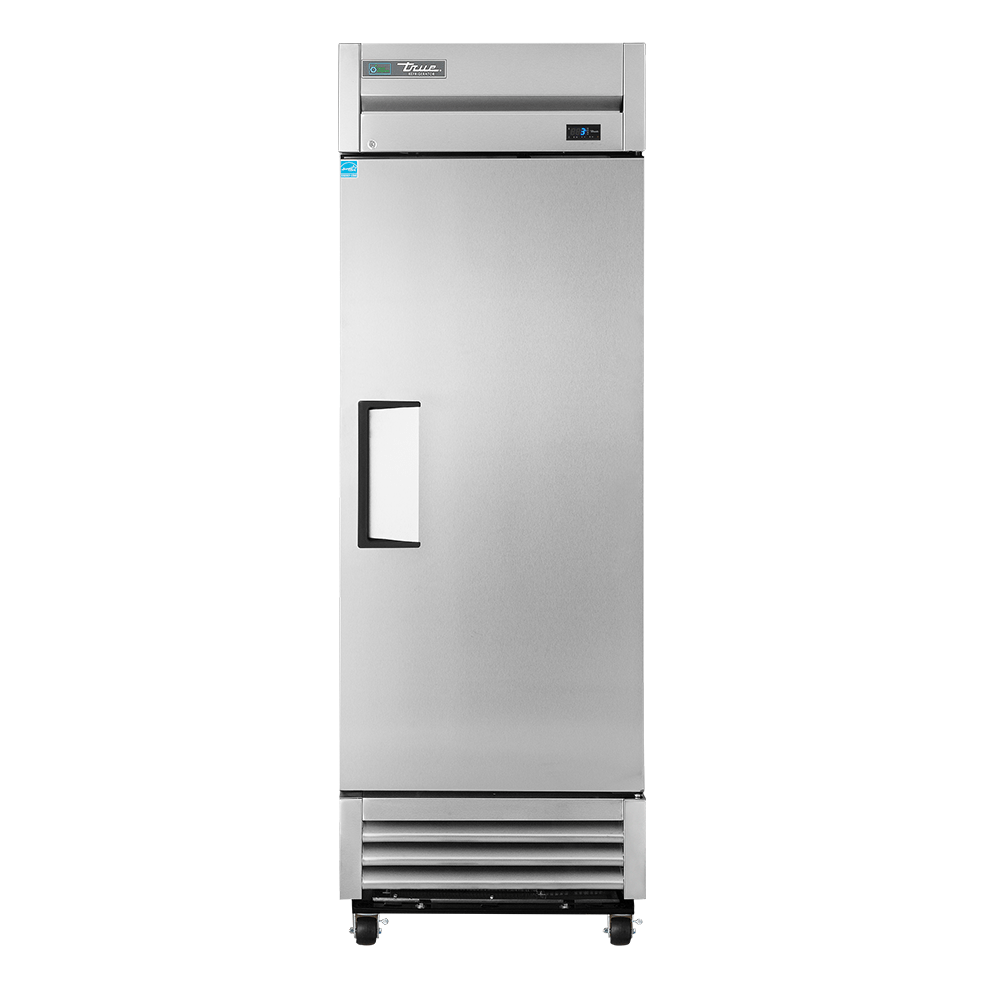
Counter refrigerators are typically waist high and are designed to provide both chilled under counter storage and valuable worktop food prep space inside a kitchen. The counter surface is usually constructed from durable materials such as stainless steel and has the added benefit of being a solid countertop for other kitchen appliances.
Counters are incredibly versatile and make for a perfect space-saving unit. Combining under-counter refrigeration with a sturdy worktop helps improve efficiency in any kitchen and makes the best use of the space available. Counters can also be fitted with drawers, doors, or a combination of both, which adds flexibility to your operations and can be tailored to suit service. True’s range of TCR/F under counter units also feature left or right refrigeration system options that allow you to configure your unit to work for your operational layout.
TCR/F products are also 100% front-breathing, with zero operating clearance to the unit sides and back required, allowing for built-in installation. It can be specified with a ‘biscuit top’ for installation under a fabricated counter.
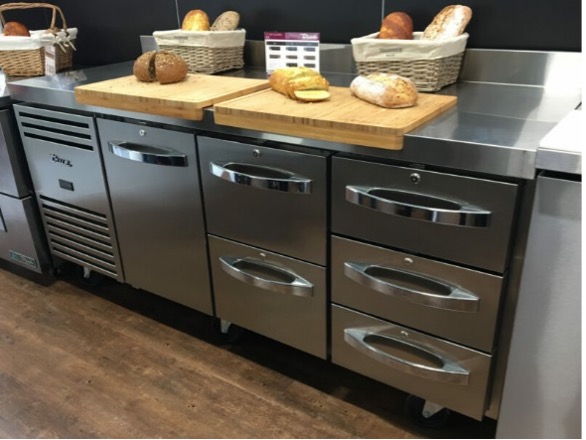
Much like counter units, prep tables combine flexible under counter storage with a useful worktop. However, prep tables also boast added versatility with refrigerated pans where chilled food is easily accessible.
Prep counters are ideal for quick-service restaurants such as sandwich shops and pizzerias, featuring configurable Gastronorm pan space. They’re able to accommodate a combination of pan sizes tailored to your operation, with large capacity refrigerated storage for easy replenishment.
True’s range of prep units feature our most advanced prep table refrigeration system, with a unique airflow system that accurately maintains a consistent 0.5°C to 5°C temperature range, ensuring the very best in ingredient preservation.
For customer-facing operators that want to put freshness on display, glass lid prep counters provide maximum product visibility while ensuring food-safe pan temperatures.
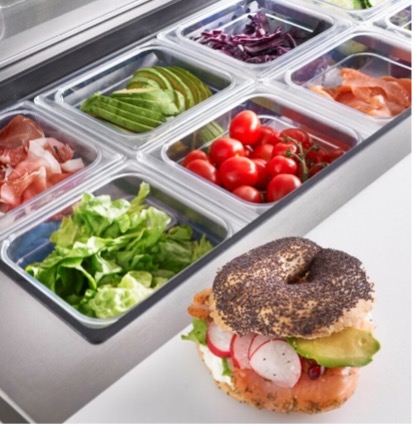
Bar refrigeration is perfect for attractively displaying and merchandising chilled products. It allows bar staff to quickly and safely access contents, even when other staff are working around them.
Because different beverages are best stored and served at different temperatures, it’s important the refrigerator you choose can be specified to hold ideal temperatures for still drinks, beers, or white wine. True’s range of bar refrigerators can be set to specific hold temperatures depending on the beverage being stored, which makes each unit perfect for any bar setting, as each unit can be customized to suit service and product type.
Bar refrigerator doors can also be configured in three types: solid swing, glass swing or glass slide. Swing door options feature reversible door hinging and a ‘stay open’ feature, for easy restocking whereas slide doors are great for smaller, narrower spaces where the frequent opening of a refrigerator door would be problematic.
As well as being suitable for service, bar refrigerators must be attractive enough to tempt custom. Many bar fridges, like those made by True, boast LED interior lighting to showcase products in their best light, plus can be customized further with different door options, external finishes and your choice of system section – left or right.
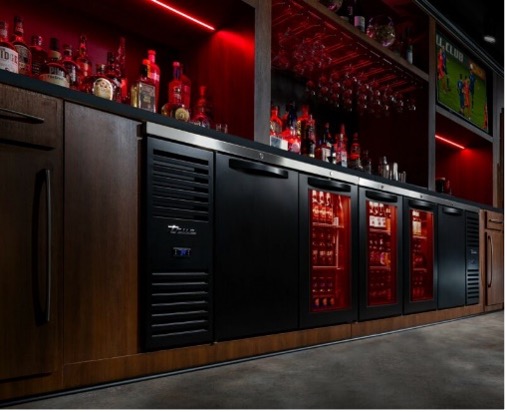
Air curtain refrigerators enhance food merchandising, acting as the ultimate impulse sale generator as their large open designs make it easy for customers to buy.
Air curtain refrigerators often come in a vast selection of sizes and styles, from small space-saving designs for businesses limited in space, to the larger versions for big canteens and self-service areas.
As well as boasting a variety of sizing options, many air curtain refrigerators feature individual LED lighting per shelf level for a vibrant display that places maximum attention on the products being stored helping to tempt custom.
Many air curtain refrigerators feature an energy-conserving roller Night Blind which can be applied outside of busy service times to reduce energy consumption and bills by as much as 20% – which helps preserve energy and running costs.
When buying air curtain refrigeration, it’s important to be mindful of the new regulation introduced in 2021 in Europe and the UK. It requires commercial retail refrigerators and freezers to meet minimum energy performance standards and carry energy labels – don’t purchase anything you are not sure complies. For more information about industry changes, check our Be Ready page.
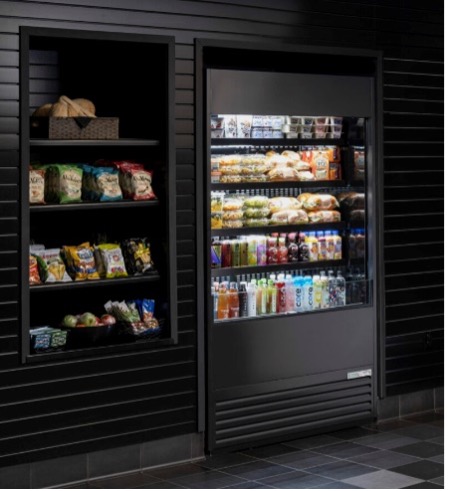
When choosing new equipment it’s helpful to understand what it will cost you to operate and maintain it, and the potential impact on your organization’s carbon footprint and sustainability targets.
It is important that operators understand and factor into their purchase decision not only the initial capital cost of equipment but also the operating costs over the lifetime of the product.
The Energy Labelling Regulation made it mandatory for manufacturers to publish comparable energy consumption data about their products, allowing operators to benchmark running costs of similar products.
In some cases, operating cost can equate to several times the purchase cost over the product lifetime, and it is often the case that cheaper equipment is less energy efficient, sometimes significantly so. Only by understanding the amount of energy consumed can you make a fully informed decision.
Top Tip: Factor in the lifetime running cost, along with the purchase price of the product and additional benefits such as longer warranty periods to determine which product represents the best value.
No matter which type of refrigerator you decide to buy it’s important to be aware of industry regulations and legal requirements in order to make a fully informed purchase decision.
Rules around the sale and use of professional refrigeration equipment have changed significantly over the last few years.
A new refrigerator you buy today may be removed from the market in less than 12 months due to further regulatory changes.
From January 2022, the sale of new commercial refrigeration equipment using R134a refrigerant will be banned (under the F-Gas regulation) due to its high GWP. Many operators also may not be aware that as of March 1st, 2021, glass door and multideck commercial refrigeration cabinets were required to start meeting minimum energy performance standards and carry energy labels.
As of today, many of these products on the market for sale still do not have the required information published. We would urge diligence before buying any applicable product if the manufacturer is not making the required information available. Of course, if the operator is not up on all of these things, they may not know to look or ask. True advise becoming familiar with the relevant aspects of F-Gas and the Energy Labelling regulations before making any commercial refrigeration purchase.
Whether you’re looking to buy your first refrigerator, replace an older model, or just curious about whether you could save money and make a more positive environmental impact by upgrading to newer products we hope this blog has made your decision a little easier.
For more tips and advice, please don’t hesitate to get in touch with a member of our team. We’d love to help.